Stimson Residence
1891 – Carroll H. Brown
2421 South Figueroa Street – map
Declared: 5/16/79
Historic-Cultural Monument No. 212 is the sole remaining mansion on what was, a hundred years ago, a long stretch of stately homes known as “Millionaire Row” on South Figueroa Street. If there could be only one left standing, though, I reckon it should be this one, a home the Los Angeles Times once called “the costliest and most beautiful private residence in Los Angeles.” The city says it’s the only example of Richardsonian Romanesque architecture remaining in Los Angeles.
Thomas Douglas Stimson was born in French Mills, Canada. He left his childhood home in New York at the age of fourteen, later working as a trader in a Muskegon, Michigan, lumber camp. He went on to further his fortune in Chicago before retiring to Our Fair City in 1890. Here he quickly set to hiring to design this three-and-a-half-story, thirty-room mansion on the eastern edge of West Adams a young architect by the name of Carroll H. Brown.
Brown was born in Illinois in 1863. By the time he worked on the Stimson Residence, although he was only twenty-seven-years-old, he was already a prominent SoCal architect, having designed downtown mansions for Louis Shiveley, H.L. MacNeil, and W.A. Clark. He also created a $7,000 monument in Wilmington for Gen. Phineas Banning. Within the next few years, the architect would go on to build the first home for the California Club, Santa Monica’s Keller Block building on Broadway, and T.D.’s six-story Stimson Block at 3rd and Spring, the largest office building in L.A. at the time (demolished in 1963). He was a charter member of the Architectural Association of Southern California, formed in 1892 and which became the Southern California Chapter of the AIA two years later. Brown became its president in 1907. He died in L.A. in 1920.
Brown’s Stimson Block
I know I’ve been including lots of Sanborn fire insurance maps lately, but here’s one more from 1894. Check out the “open cement zanja” running through Stimson’s front yard. And I don’t know when the city removed that big star lying in the middle of the street, but I’m glad they did.
Stimson’s new 12,800 square-foot home (the square footage not including the crenellated tower) covered in red Arizona sandstone cost him anywhere from $130,000 to $200,000, as I’ve seen it pegged at a few different prices (I’d think it were more toward 130 g’s; while that was still a lot of money in those days, 200 grand was a lot of lot of money). This new home of the former lumberman consisted of room after room paneled in an incredible variety of woods, including ash, walnut, sycamore, birch, gumwood, mahogany, oak, and something called monkeypod.
I’m including the following three vintage shots, each for a different reason. The top photo, from the CA State Library, is the earliest of the landmark I could find. It shows the northern side of the building, a view obscured today. The next, from the same source, is from around 1895. What’s extra cool about this one is it shows a glimpse of L.A. City Councilmember Frank Sabichi’s home next door. Frank’s house, like the rest of the mansions along South Fig, is long gone, today the parking lot for St Vincent de Paul’s. Finally, there’s a later picture of the Stimson Residence. This one, from the L.A. Public Library, shows off that zanja running along the front of the property.
The biggest event in the landmark’s 128-year history occurred just about this time of year in 1896 when, at 10:30 p.m. on February 6, someone placed “a stick of giant powder… against the foundation of the building on the south side, just in rear of the front veranda” causing a huge explosion “heard for miles around.” There were no injuries sustained in the dynamiting, and “the stately architectural pile was scarcely even shaken.” It was also reported T.D. came “out of the house… viewed the hole torn in the ground at the side of the house… laughed softly and retired to his castle.”
A month later, private detective Harry L. Coyne was arrested for the crime. The reasoning behind the deed seems the stuff of the better Columbo episodes. Coyne, having escorted Stimson’s son to Mexico City, told T.D he had uncovered a plot against the retired lumberman/financier. Following the dynamiting, Coyne offered to give information regarding the crime to Stimson, but for a price. After offering to police to implicate three men in the crime for sixty dollars, Coyne went back to Stimson and demanded $250. Ultimately, though, Coyne’s knowledge of the crime’s details did him in. He was sentenced to five years in Folsom.
T.D. Stimson died in the house on January 31, 1898, at the age of seventy (“the smoothest pickpocket in the city”, “Mother” McGarey, attended the funeral to practice her vocation, but was thwarted by mourner Police Chief Glass). Stimson’s family remained in the house until 1907 (or maybe 1904) when they sold it to civil engineer Albert Solano. Edward Maier, the owner of both the Maier Brewing Company and Hap Hogan’s Vernon/Venice Tigers of the Pacific Coast League, bought the home in 1918, hosting parties with guests including the likes of Jack Dempsey, Barney Oldfield, and Burbank’s Boilermaker, Jim Jeffries.
The Carriage House
In 1940, USC’s Pi Kappa Alpha fraternity bought the former Stimson estate for a cool $20,000, mere pocket change today. Eight years later, Mrs Edward Doheny, who had been living behind the building and was fed up with the frat-house racket, purchased the house for $70,000. She then bequeathed the home to the Sisters of St Joseph of Carondelet, an order part of the Roman Catholic Church (while the congregation’s origins go back to 17th-Century France, the Carondelet part comes from a town in Missouri). The Sisters used the home as a convent until 1969. For the next twenty years, the nuns allowed Mount St Mary’s College on Chester Place to use the house as a student residence. After returning to use as a convent, the home required a million-dollar restoration in the mid-90s due to damage sustained in the Northridge earthquake. You can see the landmark pop up in movies and TV shows now and then, including as the funeral home in Pushing Daisies.
I always wondered why the Stimson Residence wasn’t one of the first sites landmarked by the Cultural Heritage Board back in the sixties. Turns out it wasn’t for lack of trying. The first attempt at declaring the home an HCM happened in March 1965. The archdiocese resisted monument status to such an extent that it wasn’t until 1975 when the issue was again raised. Again, the archdiocese resisted, citing the designation would produce “undue restrictions on… [the] use and enjoyment of the property.” However, thanks mainly to a guy named Richard Mouck who really lobbied for dedication, the house of Stimson was officially landmarked in May 1979, a year after it was listed on the National Register of Historic Places.
Finally, please see Don Sloper’s Los Angeles’s Chester Place for a bunch of interior photographs (and of this section of West Adams in general).
Sources:
“New Buildings.” The Los Angeles Times; Oct 20, 1885, 0_4
“Dynamite Fiends” The Los Angeles Times; Feb 7, 1896, p. 10
“Last Hope Gone.” The Los Angeles Times; Mar 18, 1897, p. 9
“Stricken Down.” The Los Angeles Times; Feb 1, 1898, p. 11
“Old Mother M’Garey.” The Los Angeles Times; Feb 4, 1898, p. 14
“Famous Figueroa St. Mansion to Be Converted to Convent” The Los Angeles Times; Oct 18, 1948, p. A1
Doherty, Jack “Castle Keep” The Los Angeles Times; Jan 2, 1994, p. 12
Sloper, Don Los Angeles’s Chester Place Arcadia Publishing 2006 Charleston, SC, Chicago, IL, Portsmouth, NH, San Francisco, CA
Cooper, Suzanne Tarbell, Don Lynch, and John G. Kurtz West Adams Arcadia Publishing 2008 Charleston, SC, Chicago, IL, Portsmouth, NH, San Francisco, CA
Up next: S.S. Catalina
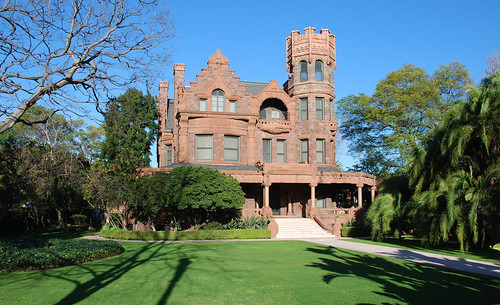
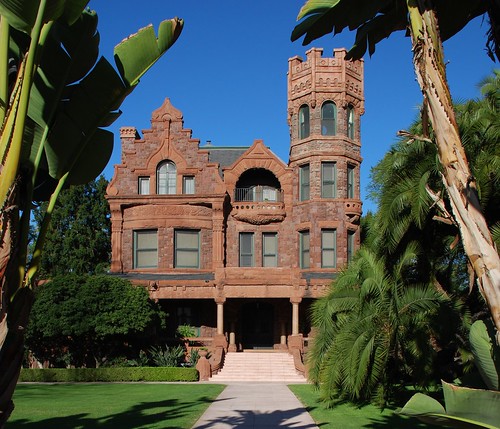
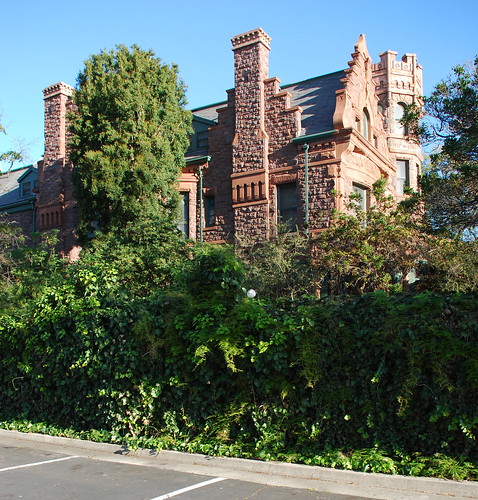

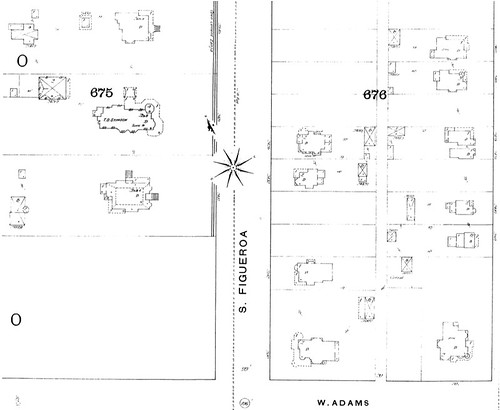
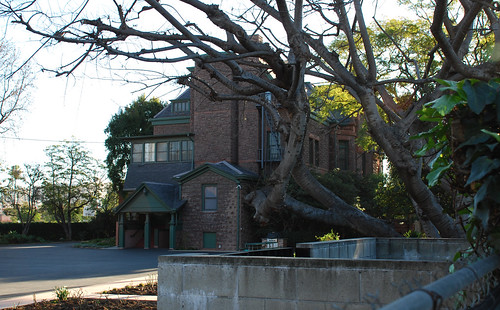
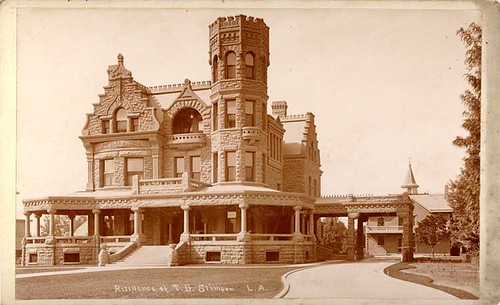
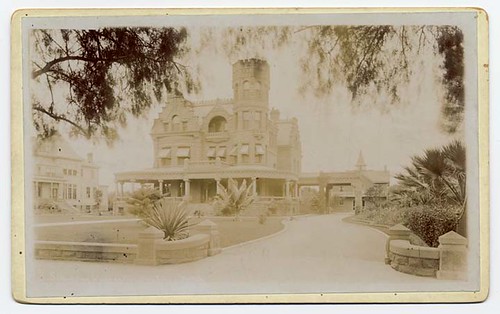
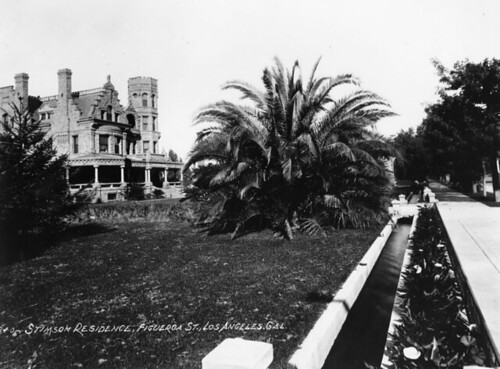
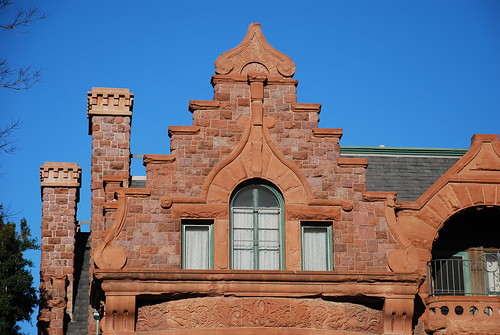
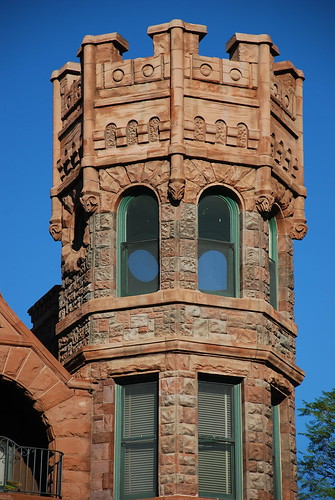

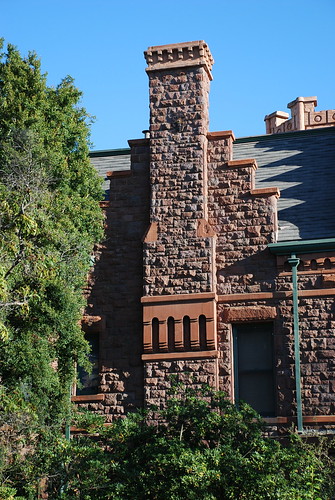
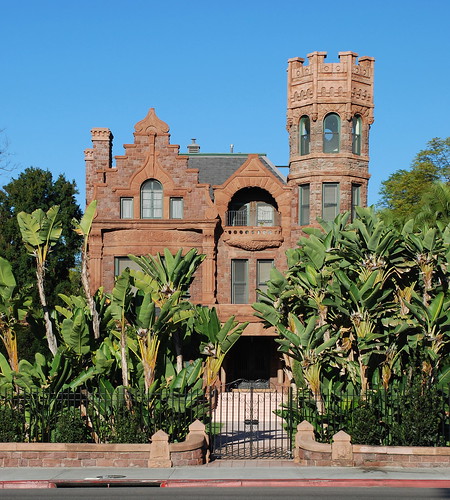

18 comments:
Hey - this is great stuff. I really enjoy your posts. Can you throw a "Follow Me" widget on your blog so I can be listed as one of your blogger.com followers?
I'm writing a short little post with some photos of Brown's Keller Block building in Santa Monica and I just wanted to say thank you for including so much background on him.
Great buildings!
Will do, Tom. Looking forward to Keller Block post.
It is such a fabulous structure. I lived on Portland St. off of Adams for 3 yrs while at SC & never once saw this building. Another case of youth being wasted on the young. I'm going back to read more - glad the house was only in hands of frat boys for a short time.
Wow, this is a stunning building. Your post makes me want to go down there and look at it today!
The "Paraiso Restaurant" sign on the Stimson Building still exists on a storefront at Third just west of Main St.
Right. I found that out from jericl cat's comment on Flickr. Thanks, Bert.
I love this architecture. So, the building still belong's to the church, correct? Do they ever let people see the inside?
Yes, the church owns the landmark. No, it's not open to the public (at least not that I know of).
What a beauty! I miss my old L.A.
great information here. i've been in los angeles for 7 years and pass by the stimson house every day on my way to work and i've always wondered what it was/is. so far this is the best site i've found yet, so thanks for sharing. are there any interior photos around anywhere?
Anonymous, for interior shots see Don Sloper's book, Los Angeles's Chester Place. And thanks for the compliment.
My Aunt is A Nun that actually occupies the house. She hosted our annual family reunion there this year (June 2009). I had the pleasure of touring the home and it was the most beautiful home I've ever seen. The amount of detail inside, from door hinges to beautiful stain glass windows, is amazing. The Basement is just as amazing.
Anyone know who to contact about using this house for filming a student film?
Hey, Floyd,
I knew the name Stimson was familiar. I think that T D Stimson was the father of C D Stimson, a Seattle lumber tycoon, who profited from the 1889 Seattle Fire, recovery from which drove a demand for more building materials. C D Stimson built a mansion on Seattle's First Hill that is one of Seattle's best-known historical landmarks.
You can read about it here:
http://www.historylink.org/index.cfm?DisplayPage=output.cfm&file_id=2713
Thanks for the link, Aunt Snow. I love that Stimson-Green mansion.
I went to USC and always wondered about that building. Great to finally know the whole story! Interesting picture of the zanja- also interesting how the street has changed over time.
IN CHECKING OUT HISTORICAL PLACES IN LA AND THERE ARE PLENTY..NOTHING ABOUT OLVERA ST.I AM DISSAPOINTED....WE HAD THE MEXICAN AND SPANISH CULTURE BEFORE ANYTHING ELSE....SINCERELY, EMMA LOPEZ
Thanks for extremely informative & useful info. I lived in Southern Cal for 20 years & never saw Stimson mansion, but I rarely went south of my workplace at Occidental Life building. I'm researching book about a Stimson associate, William H. Bradley, millionaire Wisconsin lumberman & founder of Tomahawk, Wis. Next time I'm in LA I'm going to make it a point to go to Figueroa & Adams.
Ron Johnson
Post a Comment